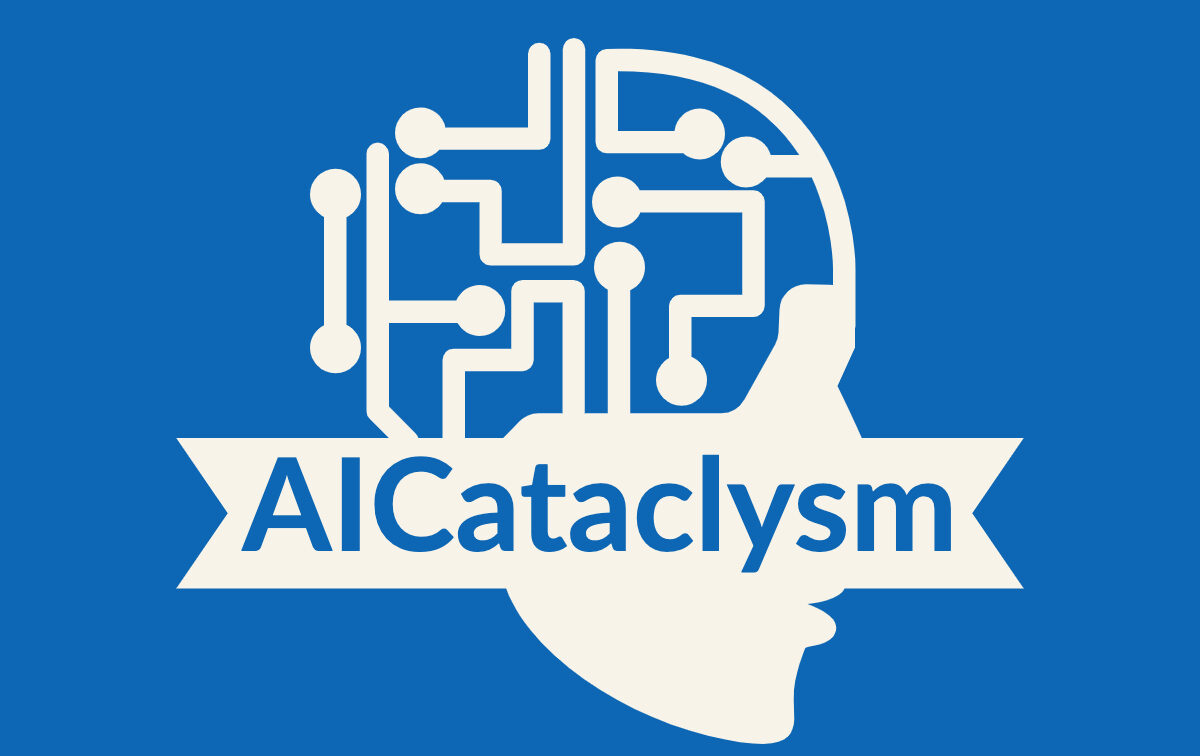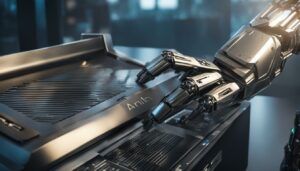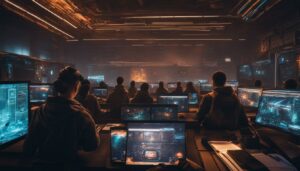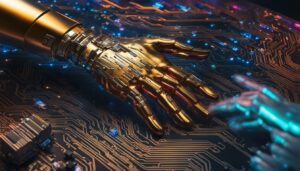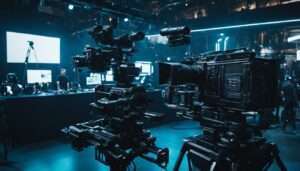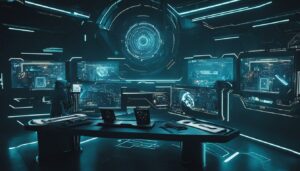The rapid advancement of technology has brought about a significant moment of innovation in the field of 3D animation. There is a debate about the future role of human 3D animators as Artificial Intelligence (AI) continues to grow. Will AI eventually replace 3D animators and revolutionize the animation industry? In this article, I delve into this thought-provoking question, exploring the capabilities of AI, its current role in 3D animation, and what the future might hold for animators in the age of AI.
Key Takeaways:
- AI advancements have streamlined and automated certain aspects of the animation process.
- AI software assists animators in tasks like crowd animation, facial expressions, and physics simulations.
- AI and human animators can collaborate to produce emotionally compelling animations.
- AI can speed up the animation process and lead to cost savings for animation studios.
- The future of animators lies in embracing AI, focusing on creativity, and continuously upskilling.
The Advancements of AI in Animation
Advancements in Artificial Intelligence have greatly impacted the field of animation. AI-powered tools and algorithms have made the animation process more streamlined, efficient, and accessible. These tools use machine learning and deep learning techniques to automate certain aspects of animation.
AI can perform tasks like character rigging, motion tracking, and generating basic animations automatically. It can analyze and process vast amounts of data to create realistic movements and behaviors.
While AI excels at repetitive and data-driven tasks, it lacks the creativity, imagination, and emotional intelligence that human animators bring to their work.
Despite its limitations, AI has proven to be an invaluable asset to animators by speeding up the animation process and improving efficiency. By automating certain tasks, AI allows animators to focus more on the artistic and creative aspects of their craft.
| Advancements in AI in Animation | Benefits |
|---|---|
| Automated character rigging | Reduces time and effort for animators |
| Motion tracking | Enables realistic movement analysis |
| Generating basic animations | Streamlines the animation process |
While AI can automate certain aspects of animation, it cannot replace the role of human animators entirely. The collaboration between AI and human creativity is key to achieving the best results in the animation industry.
The Current Role of AI in 3D Animation
AI has already become an indispensable tool in the 3D animation pipeline. It assists animators in accelerating their workflow, allowing them to focus on more artistic and creative aspects of their craft. AI-driven software can help in tasks like crowd animation, facial expressions, and physics simulations, enhancing the overall quality and efficiency of the animation process.
AI-powered animation tools automate certain aspects of animation, freeing up animators’ time and effort. For example, crowd animation, which involves simulating the movement of a large group of characters, can be a time-consuming task. AI algorithms can analyze patterns of movement and generate realistic animations for a crowd, reducing the workload for animators.
Facial expressions are another crucial element in bringing animated characters to life. AI can analyze and interpret facial movements, allowing animators to create more nuanced and expressive characters. This helps in conveying emotions and adding depth to animated stories.
Physics simulations play a vital role in creating realistic animations. Whether it’s a character interacting with the environment or objects interacting with each other, physics simulations ensure that the animation behaves naturally. AI algorithms can make these simulations more accurate and efficient, giving animators more control over the physics-based movements in their animations.
While AI plays a significant role in automating certain aspects of the animation process, it’s important to note that it cannot fully replace the role of human animators. The creativity, imagination, and artistic touch that animators bring to their work are irreplaceable. AI is a tool that assists animators, allowing them to work more efficiently and effectively.
A collaborative partnership between AI and animators is the key to unlocking the full potential of 3D animation. By leveraging the capabilities of AI, animators can enhance their creative process, streamline their workflow, and push the boundaries of what is possible in animation.
The Relationship Between AI and 3D Animators
Contrary to popular belief, AI is not here to replace 3D animators but rather to collaborate with them. The true potential of AI lies in its ability to augment and enhance the capabilities of human animators, freeing them from repetitive tasks and enabling them to explore new creative horizons. AI can handle repetitive and time-consuming tasks, while animators can add their artistic touch and creativity to produce emotionally compelling animations.
“The collaborative partnership between AI and animators is the most effective approach in the animation industry.” – John Johnson, Animation Expert
This collaborative partnership between AI and animators opens up endless possibilities for pushing the boundaries of creativity. By leveraging AI technologies, animators can focus on storytelling, character development, and visual aesthetics rather than getting caught up in tedious and time-consuming tasks. With AI handling the technical aspects, animators can dive deeper into their artistic process, injecting their unique style and vision into the animations they create.
AI not only assists animators in their work but also provides them with new tools and techniques to explore. For example, AI-powered algorithms can analyze vast amounts of data and generate suggestions for movement patterns, visual effects, and innovative animation approaches. This collaboration between human animators and AI opens up new creative horizons, allowing for the development of groundbreaking animation techniques that were previously unimaginable.
While AI augments the work of animators, it’s essential to remember that it cannot replace the artistic touch and emotional depth that human animators bring to their craft. Animators have the unique ability to infuse their creations with storytelling, emotion, and a deep connection with the audience. These aspects are what make animations truly impactful and memorable.
With the collaborative partnership between AI and animators, the animation industry is experiencing a powerful fusion of technology and creativity. Animators can harness the benefits of AI’s efficiency and automation while maintaining their artistic integrity. By embracing AI, animators can explore new creative avenues, develop innovative animation techniques, and deliver exceptional animations that captivate audiences worldwide.
| AI’s Contribution | Animator’s Expertise |
|---|---|
| Handles repetitive and time-consuming tasks | Adds artistic touch and creativity |
| Streamlines the animation process | Infuses animations with storytelling and emotion |
| Automates certain aspects of animation | Brings characters to life with depth and relatability |
| Offers data-driven suggestions | Injects unique style and vision |
Together, AI and animators have the power to reshape the animation industry, taking it to new heights of creativity and innovation. The future holds endless possibilities as this collaborative partnership continues to evolve, enabling animators to push their creative boundaries and captivate audiences with emotionally rich and visually stunning animations.
The Impact of AI on 3D Animation
Artificial Intelligence (AI) has had a significant impact on the world of 3D animation, revolutionizing the way animations are created. With the use of AI-powered tools and technologies, the animation process has become faster, more efficient, and more realistic. Let’s explore the various ways in which AI has transformed the animation industry.
Speeding Up the Animation Process
One of the key benefits of AI in 3D animation is its ability to speed up the animation process. AI-driven tools can automate repetitive tasks, allowing animators to focus more on the creative aspects of their work. By reducing the time it takes to create complex scenes, AI tools enable animators to work more efficiently and meet tighter deadlines. This increased speed and efficiency contribute to overall cost savings for animation studios.
Creating Realistic Animations
AI has also played a crucial role in improving the realism of animations. Through motion capture systems powered by AI algorithms, real-life movements can be analyzed and applied to 3D characters, resulting in more natural and lifelike animations. AI can accurately replicate human actions and behaviors, adding an extra layer of authenticity and believability to animated characters and objects.
Cost Savings for Animation Studios
Another significant impact of AI in 3D animation is its potential for cost savings. By automating certain tasks and streamlining the animation process, AI can reduce production costs for animation studios. This is especially evident in projects that require a large number of characters or complex scenes. With the help of AI, studios can achieve high-quality animations while keeping their production budgets in check.
AI in 3D animation has sped up the animation process, resulting in cost savings for animation studios and more realistic animations through the use of motion capture systems.
However, it’s important to acknowledge the limitations of AI in animation. While AI can enhance certain aspects of the animation process, it lacks the human creativity and imagination that animators bring to their work. AI algorithms are unable to replicate the artistic choices and emotional depth that animators infuse into their animations. Additionally, there are concerns about potential job displacement in the animation industry due to the automation capabilities of AI.
The Human Touch in Animation
No matter how sophisticated AI becomes, it cannot replicate the human touch that animators bring to their work. The art of animation goes beyond movement; it involves storytelling, emotion, and connecting with the audience on a deeper level. Human animators infuse life into characters, making them relatable and memorable.
AI can serve as a time-saving tool in the animation industry, allowing animators to focus more on refining their work and adding their artistic flair.
“No painter can reproduce this atmosphere, this magical envelope of cinema, that has been created by hundreds of human beings who are committed to giving it their all.” – Yuri Norstein
While AI may be able to replicate movements and actions, it is the human touch that brings characters to life and elicits genuine emotional responses from audiences. The ability to infuse animations with subtle nuances and authenticity is a skill that only human animators possess.
The Power of Storytelling
In animation, storytelling is crucial for engaging the audience and creating a lasting impact. Human animators understand the power of a well-crafted narrative and know how to use visuals, dialogue, and character development to evoke emotions and captivate viewers.
The Emotion Connection
Emotion is a fundamental element of animation. Human animators are able to convey complex emotions through the subtlest of movements, creating a deep emotional connection with the audience. These emotional nuances are what make animations truly memorable and impactful.
Building a Connection with the Audience
Animation is a collaborative medium, and it requires animators to have a deep understanding of their audience. Human animators have the ability to tap into the thoughts and feelings of the viewers, crafting animations that resonate on a personal level and forge a strong connection.
The Artistry of Animation
Animation is an art form that goes beyond technical skill. It requires creativity, imagination, and a deep understanding of human emotions and behavior. Human animators bring their unique artistic vision and personal touch to their work, creating animations that are visually stunning and emotionally compelling.
While AI may assist in certain aspects of animation, it is the human touch that sets animations apart and leaves a lasting impression on the audience.
Comparing AI and Human Animators
| Aspect | AI Animators | Human Animators |
|---|---|---|
| Technical Accuracy | High | High |
| Artistic Vision | Limited | High |
| Emotional Depth | Minimal | High |
| Creativity | Minimal | High |
| Connection with Audience | Limited | High |
The table above highlights the stark contrast between AI and human animators in various aspects of animation. While AI may excel in technical accuracy, it falls short in areas such as artistic vision, emotional depth, creativity, and the ability to form a connection with the audience.
The Future of 3D Animators in an AI-Driven World
The future of 3D animators lies in embracing AI and integrating it into their creative workflow. As the animation industry continues to evolve, animators who adapt to AI-driven tools and techniques will find themselves at an advantage, delivering high-quality work with greater efficiency.
AI can serve as an inspiration for animators, suggesting unique movement patterns, styles, and visual elements that they can incorporate into their animations. By collaborating with AI, animators can explore new possibilities and push the boundaries of their creativity.
While AI has the potential to automate certain tasks, skilled animators will still be in demand for their ability to bring stories to life with their creativity, imagination, and attention to detail. The human touch and emotional depth that animators bring to their work cannot be replicated by AI.
However, animators must also adapt and develop new skills to thrive in an AI-driven world. Continuous upskilling and staying updated with the latest AI advancements and animation techniques are crucial for animators to remain competitive and relevant in the industry.
By embracing AI, collaborating with the technology, and continuously developing their skills, 3D animators can secure their job prospects and shape a future where human creativity and AI-driven efficiency coexist harmoniously.
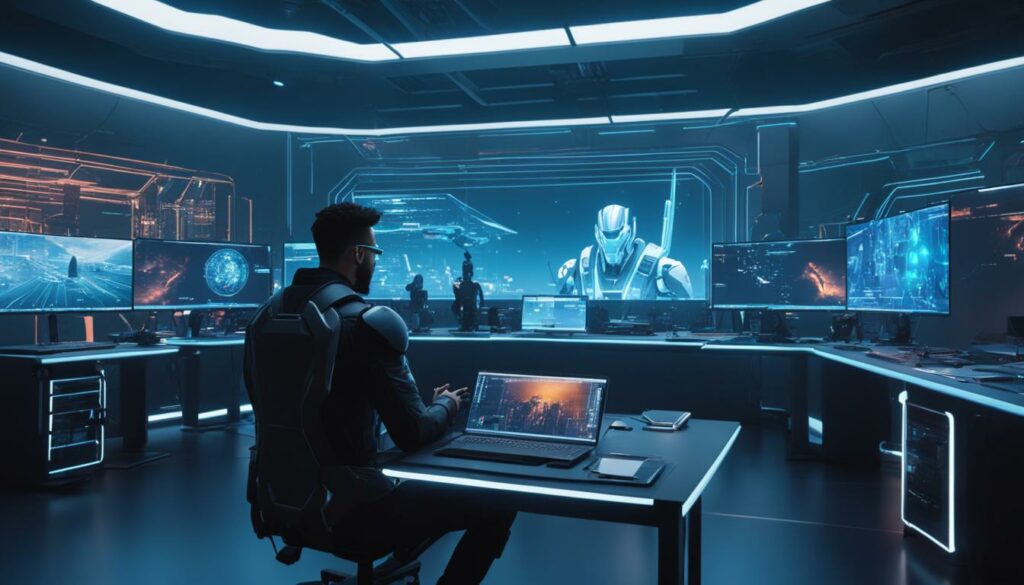
Benefits of Embracing AI in Animation
- Efficiency: AI-driven tools can streamline the animation process, reducing time and effort required for certain tasks.
- Collaboration: Animators can collaborate with AI to explore new creative possibilities, combining the strengths of both human creativity and AI-driven efficiency.
- Job Security: Skilled animators who adapt to AI will continue to be valuable assets in the industry, as AI cannot replicate their unique artistic abilities.
- Developing New Skills: Animators can develop new skills in AI-driven animation techniques, expanding their expertise and adapting to industry trends.
The Impact of AI in Graphic Design
AI has significantly advanced the field of graphic design, bringing forth a new era of possibilities. With the integration of AI-powered graphic design tools, designers can now create professional-looking designs without the need for extensive design experience. AI algorithms have the capability to generate logos, typography, patterns, and illustrations that are not only unique but also easily customizable. These AI applications have the potential to revolutionize the graphic design industry by making the design process more efficient and accessible.
However, it is important to note that although AI plays a crucial role in various design functions, human designers and creative directors still hold irreplaceable value. Their creativity and interpretation of human emotions bring a distinct touch to designs that cannot be replicated by AI. The intuition and artistic sensibilities that human designers possess contribute to establishing a deep connection between the design and its intended audience.
In summary, AI has significantly transformed the graphic design landscape. By harnessing the power of AI, designers can expedite their design process and produce visually stunning designs. However, the collaboration between AI and human creativity remains essential in delivering designs that resonate with individuals on an emotional level.
Examples of AI in Graphic Design
AI has revolutionized the field of graphic design, offering exciting possibilities for creating stunning and innovative artwork. Let’s explore some notable examples of AI applications in graphic design:
-
DALL-E
DALL-E is an AI model developed by OpenAI that can generate unique and visually captivating images based on text descriptions. It can create images of fantastical creatures, objects, and scenes that do not exist in the real world.
-
Midjourney
Midjourney is an AI-powered design tool that can generate professional-looking designs with minimal effort. It uses machine learning algorithms to analyze design preferences and automatically generates logos, typography, and layouts that align with the user’s requirements.
-
AI Dreamscapes
AI Dreamscapes is a project that explores the creative potential of AI algorithms in generating dream-like and surreal artwork. It uses neural networks to transform ordinary images into visually captivating and abstract compositions.
-
AI Portraits
AI Portraits is an AI-powered tool that can transform ordinary photographs into stunning and painterly portraits inspired by different art styles. It uses neural networks to analyze facial features and generates unique interpretations of the input image.
-
Neptunian Glitterball
Neptunian Glitterball is an AI project that explores the generation of psychedelic and vibrant visual patterns using generative adversarial networks (GANs). It creates mesmerizing and abstract designs that are visually striking and unique.
-
The Next Rembrandt
The Next Rembrandt project aimed to create a new painting in the style of the renowned artist Rembrandt using AI algorithms. Through the analysis of Rembrandt’s works, the AI algorithm generated a new portrait that emulates the artist’s style and techniques.
-
Artificial Realities: Coral
Artificial Realities: Coral is an exploration of how AI can generate intricate and visually stunning patterns and illustrations inspired by coral reefs. The AI algorithm analyzes the unique structures and forms found in coral reefs and generates captivating digital artwork.
These examples showcase the immense creative potential of AI in the field of graphic design. AI algorithms can generate unique and aesthetically appealing designs, logos, typography, and illustrations that would otherwise require significant time and expertise. By leveraging the power of AI, graphic designers can explore new artistic territories and create visually captivating artwork.
What Animators Can Do in the Era of AI
In the ever-evolving era of AI, animators find themselves at the forefront of technological advancements in the industry. To remain competitive and valued, animators must adapt to AI and embrace new technologies while focusing on their creativity and continuous upskilling. Collaboration with AI can bring about innovative animations and enhance the overall quality of their work.
As an animator, I understand the importance of embracing AI and incorporating it into my workflow. By harnessing the power of AI, I can streamline my animation process and explore new creative possibilities. AI-driven tools can automate certain aspects of animation, allowing me to concentrate on refining my artistic vision and style.
“Embracing AI and incorporating it into my workflow has allowed me to streamline my animation process and explore new creative possibilities.”
The collaboration between animators and AI is a powerful partnership that combines the human touch with the capabilities of AI. By leveraging AI’s data-driven analysis and automation, I can enhance my animations and bring them to a whole new level. AI can suggest unique movement patterns, styles, and visual elements, sparking my creativity and expanding my artistic horizons.
“The collaboration between animators and AI is a powerful partnership that combines the human touch with the capabilities of AI.”
Continuous upskilling is crucial for animators in the era of AI. Staying updated with the latest trends and best practices in the industry ensures that I am equipped with the knowledge and skills to adapt to the evolving demands of the animation world. By continuously upskilling, I can stay ahead of the curve and deliver high-quality animations that resonate with audiences.
In conclusion, in the era of AI, animators have a unique opportunity to embrace new technologies, collaborate with AI, and continuously upskill themselves. By adapting to AI and incorporating it into their workflow, animators can unlock a world of creative possibilities and produce animations that captivate audiences. The future of animation lies in the harmonious integration of human creativity and AI’s technological advancements, making it an exciting time for animators to thrive.
Animator’s Guide to Embracing AI:
- Stay updated with the latest AI advancements in animation
- Explore and incorporate AI-powered tools into your workflow
- Focus on developing your unique artistic vision and style
- Collaborate with AI to enhance your animations
- Continuously upskill and stay informed about industry trends
Conclusion
After exploring the advancements of AI in the field of animation and graphic design, it is evident that AI is not here to replace human animators and designers entirely. Instead, AI serves as a valuable tool that enhances and empowers their creative work. The future of animation and graphic design lies in the collaboration between AI-driven technologies and human creativity.
Skilled animators and designers possess unique abilities that AI cannot replicate, such as the art of storytelling, creating engaging characters, and interpreting human emotions. While AI-driven tools and algorithms can assist in streamlining and automating certain aspects of the animation and design process, human animators and designers are essential for infusing their creative touch and imagination into their work.
Looking ahead, we can foresee a dynamic blend of AI advancements and human artistry that will make the animation and graphic design industries more exciting and innovative than ever before. As technology continues to evolve, animators and designers who embrace AI, stay updated with industry trends, and continuously refine their skills will play a pivotal role in shaping the future of animation with AI.
Ultimately, the impact of AI on the animation industry will bring forth new possibilities, allowing animators and designers to push boundaries and create visually stunning and emotionally compelling content. The collaboration between AI and human creativity holds the key to unlocking the true potential of animation and graphic design in the years to come.
